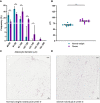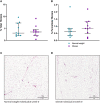Dysregulation of Subcutaneous White Adipose Tissue Inflammatory Environment Modelling in Non-Insulin Resistant Obesity and Responses to Omega-3 Fatty Acids - A Double Blind, Randomised Clinical Trial
- PMID: 35958557
- PMCID: PMC9358040
- DOI: 10.3389/fimmu.2022.922654
Dysregulation of Subcutaneous White Adipose Tissue Inflammatory Environment Modelling in Non-Insulin Resistant Obesity and Responses to Omega-3 Fatty Acids - A Double Blind, Randomised Clinical Trial
Abstract
Background: Obesity is associated with enhanced lipid accumulation and the expansion of adipose tissue accompanied by hypoxia and inflammatory signalling. Investigation in human subcutaneous white adipose tissue (scWAT) in people living with obesity in which metabolic complications such as insulin resistance are yet to manifest is limited, and the mechanisms by which these processes are dysregulated are not well elucidated. Long chain omega-3 polyunsaturated fatty acids (LC n-3 PUFAs) have been shown to modulate the expression of genes associated with lipid accumulation and collagen deposition and reduce the number of inflammatory macrophages in adipose tissue from individuals with insulin resistance. Therefore, these lipids may have positive actions on obesity associated scWAT hypertrophy and inflammation.
Methods: To evaluate obesity-associated tissue remodelling and responses to LC n-3 PUFAs, abdominal scWAT biopsies were collected from normal weight individuals and those living with obesity prior to and following 12-week intervention with marine LC n-3 PUFAs (1.1 g EPA + 0.8 g DHA daily). RNA sequencing, qRT-PCR, and histochemical staining were used to assess remodelling- and inflammatory-associated gene expression, tissue morphology and macrophage infiltration.
Results: Obesity was associated with scWAT hypertrophy (P < 0.001), hypoxia, remodelling, and inflammatory macrophage infiltration (P = 0.023). Furthermore, we highlight the novel dysregulation of Wnt signalling in scWAT in non-insulin resistant obesity. LC n-3 PUFAs beneficially modulated the scWAT environment through downregulating the expression of genes associated with inflammatory and remodelling pathways (P <0.001), but there were altered outcomes in individuals living with obesity in comparison to normal weight individuals.
Conclusion: Our data identify dysregulation of Wnt signalling, hypoxia, and hypertrophy, and enhanced macrophage infiltration in scWAT in non-insulin resistant obesity. LC n-3 PUFAs modulate some of these processes, especially in normal weight individuals which may be preventative and limit the development of restrictive and inflammatory scWAT in the development of obesity. We conclude that a higher dose or longer duration of LC n-3 PUFA intervention may be needed to reduce obesity-associated scWAT inflammation and promote tissue homeostasis.
Clinical trial registration: www.isrctn.com, identifier ISRCTN96712688.
Keywords: LC n-3 PUFA; Wnt signalling; adipose tissue; inflammation; obesity; tissue remodelling.
Copyright © 2022 Fisk, Childs, Miles, Ayres, Noakes, Paras-Chavez, Antoun, Lillycrop and Calder.
Conflict of interest statement
PCC undertakes unpaid voluntary work as the current President of the Federation of European Nutrition Societies (FENS) and as Past President of ILSI Europe. The remaining authors declare that the research was conducted in the absence of any commercial or financial relationships that could be construed as a potential conflict of interest.
Figures









Similar articles
-
Modification of subcutaneous white adipose tissue inflammation by omega-3 fatty acids is limited in human obesity-a double blind, randomised clinical trial.EBioMedicine. 2022 Mar;77:103909. doi: 10.1016/j.ebiom.2022.103909. Epub 2022 Mar 2. EBioMedicine. 2022. PMID: 35247847 Free PMC article. Clinical Trial.
-
Dysregulation of endocannabinoid concentrations in human subcutaneous adipose tissue in obesity and modulation by omega-3 polyunsaturated fatty acids.Clin Sci (Lond). 2021 Jan 15;135(1):185-200. doi: 10.1042/CS20201060. Clin Sci (Lond). 2021. PMID: 33393630 Clinical Trial.
-
Omega-3 fatty acids and adipose tissue biology.Mol Aspects Med. 2018 Dec;64:147-160. doi: 10.1016/j.mam.2018.01.004. Epub 2018 Jan 17. Mol Aspects Med. 2018. PMID: 29329795 Review.
-
A high ratio of dietary n-3/n-6 polyunsaturated fatty acids improves obesity-linked inflammation and insulin resistance through suppressing activation of TLR4 in SD rats.Nutr Res. 2013 Oct;33(10):849-58. doi: 10.1016/j.nutres.2013.07.004. Epub 2013 Aug 9. Nutr Res. 2013. PMID: 24074743
-
n-3 PUFA: bioavailability and modulation of adipose tissue function.Proc Nutr Soc. 2009 Nov;68(4):361-9. doi: 10.1017/S0029665109990231. Epub 2009 Aug 24. Proc Nutr Soc. 2009. PMID: 19698199 Review.
Cited by
-
Docosahexaenoic Acid Counteracts the Hypoxic-Induced Inflammatory and Metabolic Alterations in 3T3-L1 Adipocytes.Nutrients. 2022 Nov 1;14(21):4600. doi: 10.3390/nu14214600. Nutrients. 2022. PMID: 36364860 Free PMC article.
-
Omega-3 Lipid Mediators: Modulation of the M1/M2 Macrophage Phenotype and Its Protective Role in Chronic Liver Diseases.Int J Mol Sci. 2023 Oct 24;24(21):15528. doi: 10.3390/ijms242115528. Int J Mol Sci. 2023. PMID: 37958514 Free PMC article. Review.
-
An Atlas of Promoter Chromatin Modifications and HiChIP Regulatory Interactions in Human Subcutaneous Adipose-Derived Stem Cells.Int J Mol Sci. 2023 Dec 28;25(1):437. doi: 10.3390/ijms25010437. Int J Mol Sci. 2023. PMID: 38203607 Free PMC article.
-
Is orbital adipose tissue obesity-privileged? The relationship between small adipocyte size and metabolically healthy state from the view of orbital fat.J Endocrinol Invest. 2025 Jul;48(7):1549-1562. doi: 10.1007/s40618-025-02568-7. Epub 2025 Mar 22. J Endocrinol Invest. 2025. PMID: 40120074
-
Association of adipose tissue inflammation and physical fitness in older adults.Immun Ageing. 2024 Sep 28;21(1):64. doi: 10.1186/s12979-024-00468-7. Immun Ageing. 2024. PMID: 39342343 Free PMC article.
References
Publication types
MeSH terms
Substances
Associated data
LinkOut - more resources
Full Text Sources
Molecular Biology Databases
Research Materials

